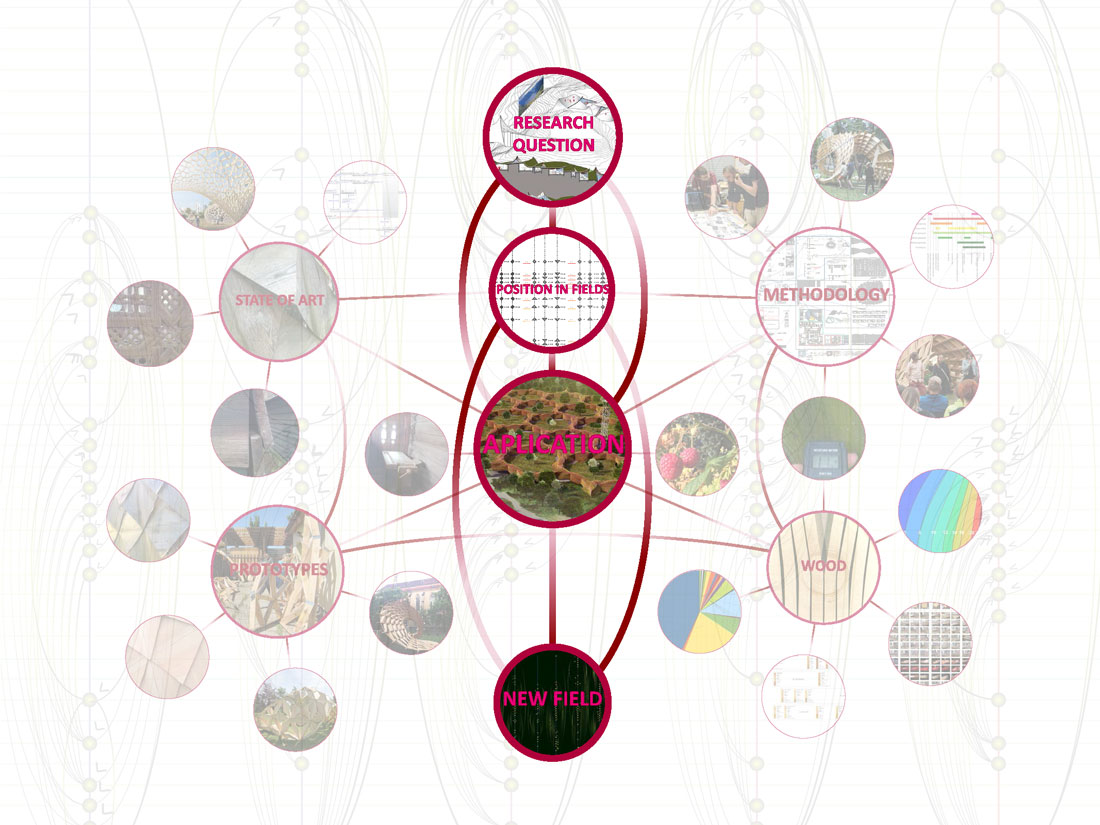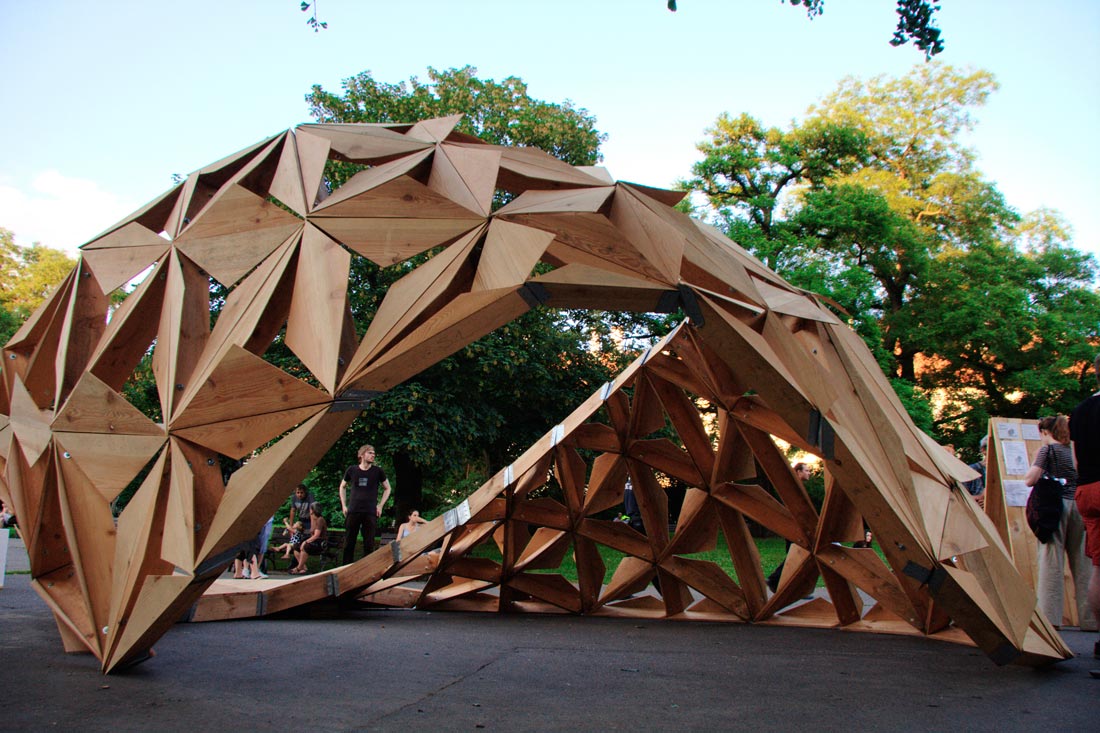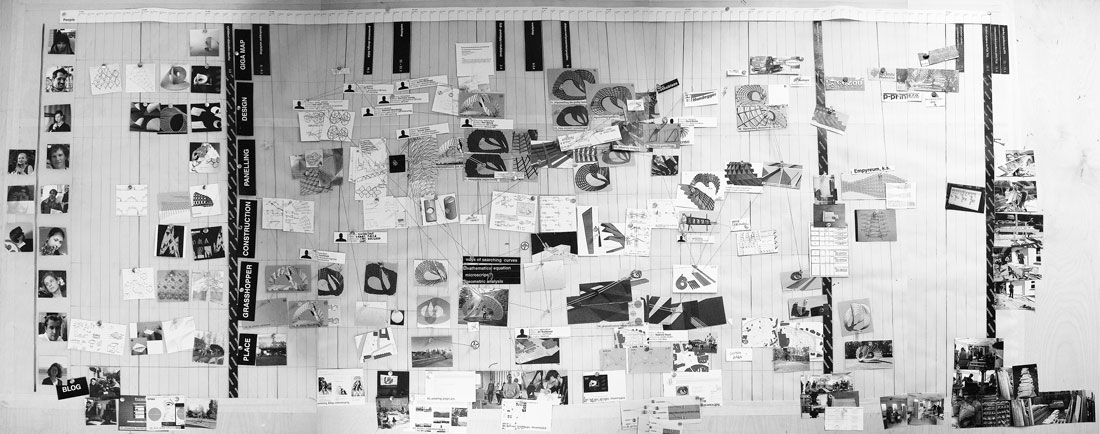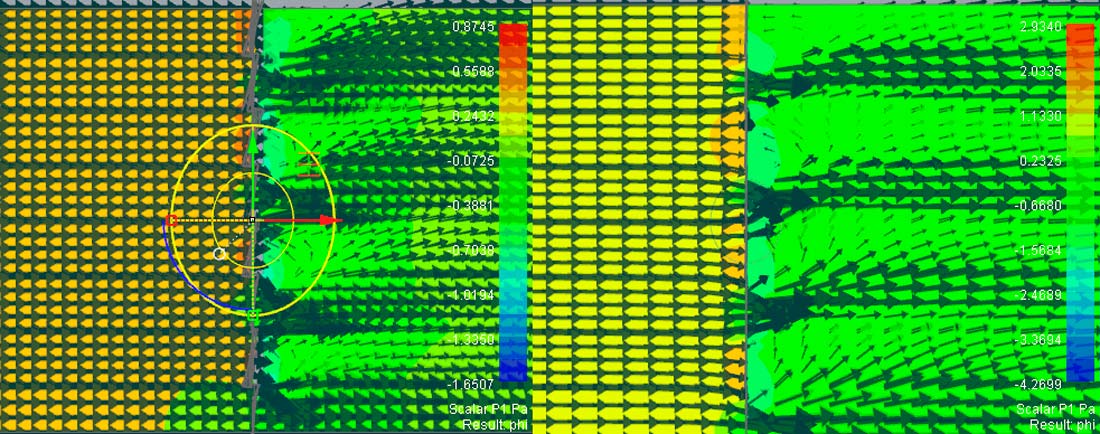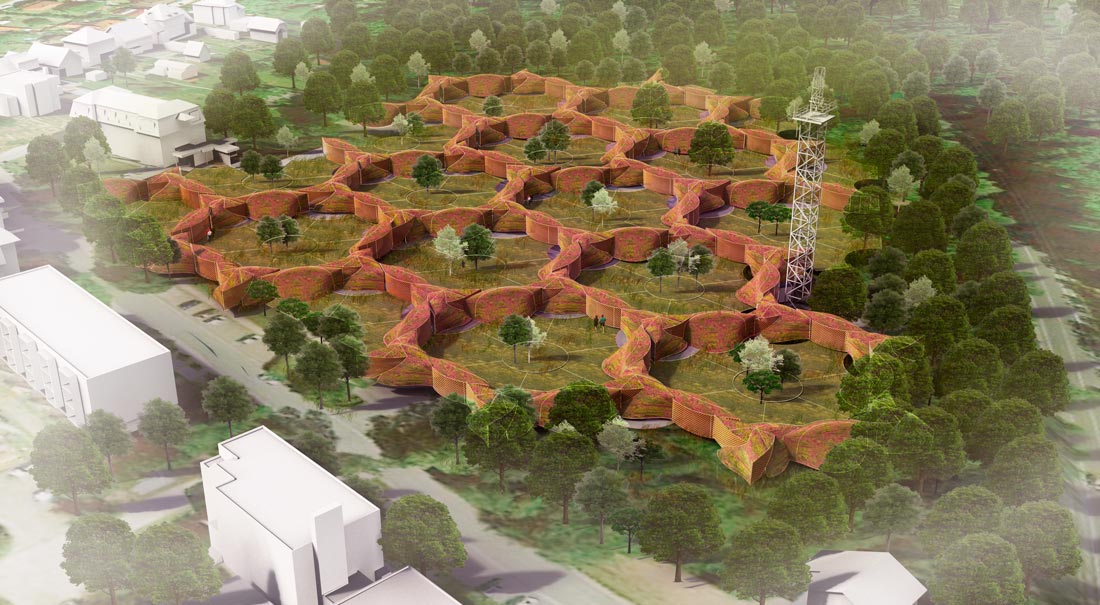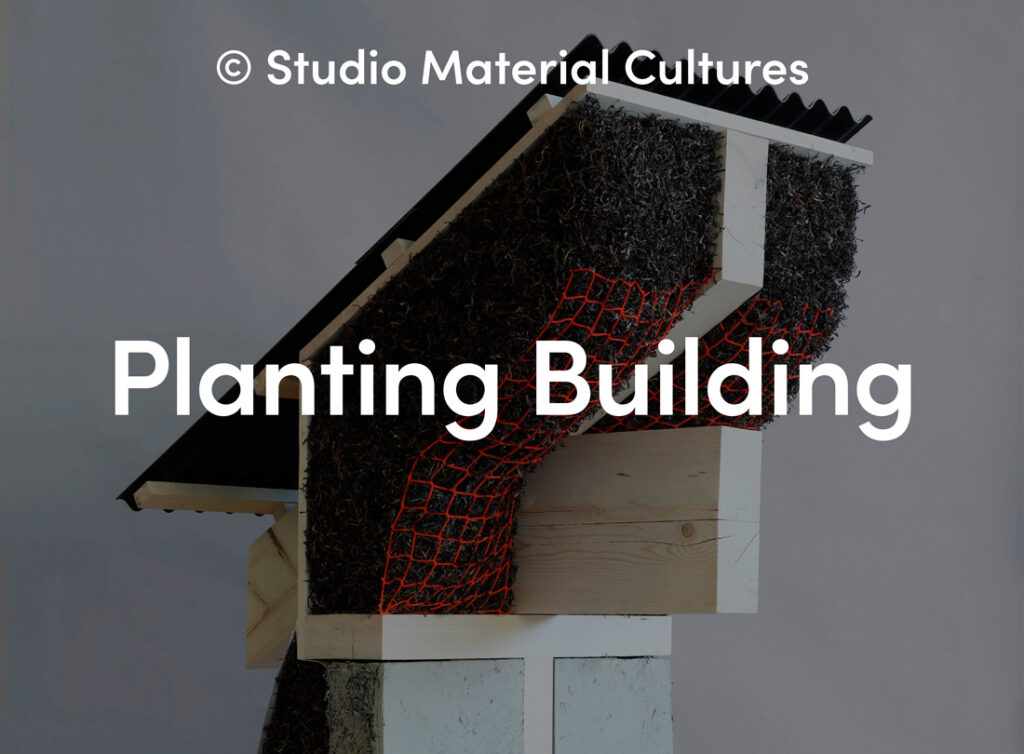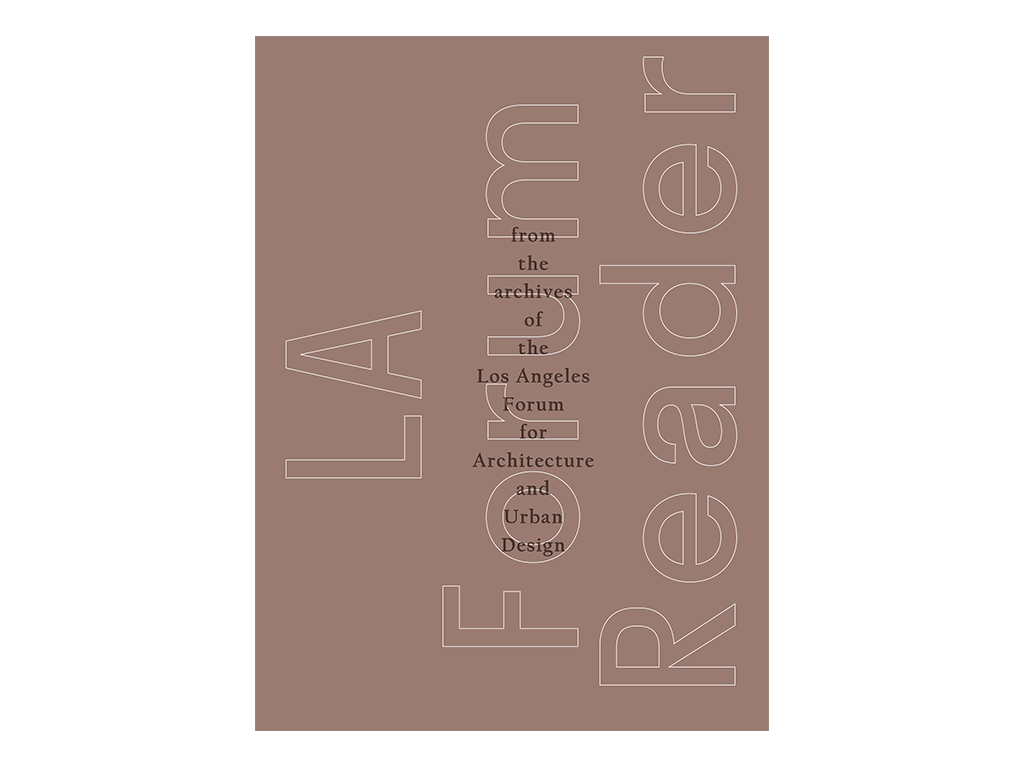The present research considers wood as a study material for a wider question on architecture’s environmental[1] interaction. It aims to explore its potential for eco-systemic[2] performances[3] and atmospheres[4] as well as to broaden the discussion on this problem area by accessing the public space and professional practice calls. My project researches such interactions through practical experiments as well as theoretical reflections, including examinations of other scientific, design, artistic and craft disciplines. It honestly discusses the successes as well as the failures and weak points to develop a strong background for eco-systemic collaborative design-research practice.
The methodology Research by Design[5] while full-scale prototyping is covered by the Systems Oriented Design[6] to interpret and develop complex environmental relations. While doing so, this work also claims develop the methodology itself and to generate theory through experimental practice. The fusion of these process based fields led to the ratification of new design field: Systemic Approach to Architectural Performance[7].
Diagram Expressing the fusion of Methodology, Material Science and Full-Scale Prototyping into One Performative Eco-System of Architectural Practice through which the New Design Field is Generated (Davidová 2018)
1 Introduction
This research by design[8] is seeking answers to the question of what is a solid pine wood’s environmental interaction and how it can be used in Performance Oriented Architecture[9] applied in Czech locations. This is looked upon from Systems Oriented Design[10] perspective. By integrating these fields from eco-systemic perspective, the work leads to the ratification of a new design field: Systemic Approach to Architectural Performance. Therefore, the case study demanded larger complexity of investigation as one cannot divide the field into fragments. This is obvious when it comes to discussion on eco-systems. Ulanowitz describes that ‘ecosystems’[11] behave in ways that are very different from the systems described by other sciences, i.e. evolutionary theory, ethology, mechanics, thermodynamics, etc. And that the ability of aggregated mechanical constructs, otherwise known as ‘eco-systems models’, to predict the behaviour of ensemble eco-systems is notoriously poor. (Ulanowicz, 1999). Therefore, he also discusses ‘Ecosystems Phenomenology’[12] (Ulanowicz, 1988). The importance of performance of the whole is also discussed by Gestalt Psychology (Wertheimer, Koffka, Köhler and others)[13]. With the understanding of above mentioned, several full scale prototypes, their production and application in architectural and ’urban design’[14] and eco-systems, design processes and the methodology itself were all interpreted through practice as fused ever evolving biotic as well as abiotic co-design, being the design-research process and the result in the same time.
This multiple approach to generate rich research is reasoned from observations of a reductionist’s architectural design applications, that were also criticised i.e. by Hemmersam and Morrison[15] in relation to local specificity (Hemmersam & Morrison, 2016), the core of this work. In the last few decades, a large amount of computer generated designs inspired by material, biological or social systems i.e. have been built. These attempts often failed to engage the main field of their inspirations, the material, the biological and the social systems themselves in real life, thus not achieving any real life performance. For this reason, and because there is not enough research in related areas, the research had to investigate and bring more multi-layered acquisitions to the fields. Architectural and Urban Design are being commonly understood as the most complex disciplines – so must be the research by design in these disciplines. Therefore, to conclude with acquisitions to only three major fields seems to be reduced to a minimum. These cover:
a) the methodology: MINI-maps, Processing Performance of the Whole, Performance of the Whole, Rich Design Research Public Space, Feedback Looping of Final Prototypes, Time Based Eco-Systemic Co-Design, Practice Generated;
b) the material research: Life Cycle Based Eco-Systemic Material Selection, Force-Hygroscopicity Relations, Time-Based Force-Hygroscopicity Relations, Angle Cut-Fibre Direction Hygroscopicity Performance, Sugar and Amyl Free, Biological De-Re-Sorption Relation, MC-Cut Hygroscopicity Relation, Material-Design Life Cycle, Introduction of Solid Wood Responsivity to POA;
c) architectural and urban design field: Responsive Solid Wood’s Application, Performance Based Beauty – Beauty’s Performance, Embodied Architectural Performance, Boundary Conditions Crossing, Onion Principle, Eco-Systemic Environmental Interaction Principle, Trans-Co-Design, Local Climatic Adaptation.
Inspired by the performance of traditional architecture from locations with more extreme climate histories, this case study mainly focuses on performative potentials of solid pine wood cut in tangential section; to be precise – its cup warping – and particularly how this might be applicable in the specific climatic conditions of Czechia. With today’s climatic change in our region, there is a necessity to search for the adaptation of our local architecture in different places where such conditions have been already present.
Research Prototypes that Are Moderating its Micro-Climatic Ambient Environments through Material-Environment Interaction Causing Sorption or Evaporation followed by Warping: pereSITE Pavilion at reSITE Festival (photo: Vágnerová 2013)
2 Theme
The Czech National Strategy for Climate Change Adaptation document clearly states that it is necessary to promote research and development of new materials and technology in reference to anticipated effects of climate change, such as strong gusty winds, extreme rainfall or snow totals or temperature extremes. The main issue in the urban environment mentioned is humidity extremes – long periods of very dry weather or extreme rains (Czech Republic Ministry of the Environment & Czech Hydrometeorological Institute, 2015). In regards to this issue, the architecture is not considered. It is important to note that architects and urbanists were excluded from the document preparation. This research claims that the experimental field of architecture and urban design may bring new perspectives to the discussion, joining climatic, material and biotic (including social), sciences. However, this investigation does not stop with material and experimental architecture alone but expands to social architecture across biotic and abiotic interactions and processes. This is necessary to investigate how such material technologies can become a realistic contribution to architecture and built environment in its eco-systemic performance. Such was investigated through practice – individual and collaborative GIGA-mapping[16] and full scale prototyping, both exposed to public space or a highly -biotic environment for interaction. Furthermore, this acquired data and registering from vernacular architecture were examined by collaborative trans-disciplinary practice project application.
The work covers ‘down to earth’ exemplification of two sub-projects resulting in four built prototypes: Performative Screens Ray and Environmental Summer Pavilions, where prototypes Ray 2, Ray 3, pareSITE and LOOP pavilions (see Figure 1) benefit from each other’s ideas, observations and design results. The Ray project that was inspired by Norwegian traditional panelling and Oriental screens called ‘mashrabīyas’[17] is proposing a screen that is airing and improving the environment by evaporating humidity in warm, dry weather while being resistant and sorping moisture in high relative humidity. The pavilions were mainly focused on moderating ‘urban heat islands’ (Wong, Hogan, Rosenberg, & Denny, 2016) through circulation of evaporated humid air such as in ‘mashrabīyas’, while using the idea from Norwegian traditional panelling of warping for humid air movement generation. These architectures were improving/may improve outdoor-indoor climatic comfort by providing shading and wind sheltering but also sorping moisture in high relative humidity level that occurs mainly at nights, while evaporating it on hot summer afternoons, when the relative humidity is on average the lowest. According to Banham, humidity has been the most pestiferous, subtle and elusive of control for most of architectural history, either too much or too little of it in certain climatic conditions (Banham, 2009). These prototypes wish to take this discussion further through not control but its moderation practice, applied for the location with both extremes and their increase expectations, as stated in Czech National Strategy for Climate Change Adaptation (Czech Republic Ministry of the Environment & Czech Hydrometeorological Institute, 2015).
3 Design-Research Inspirations, Motivations and Practice
This research on solid wood cut in a tangential section (see Figure 3) was greatly inspired by contemporary research on ply-wood and laminates, conducted by Michael Hensel, Achim Menges and others and research of Sustainable Environment Association (Hensel, 2011b) co-founded by Michael Hensel, Defne Sunguroğlu Hensel and Birger Sevaldson that recently joined the Ocean Design Research Association (Hensel, 2015a). In the September/October 2015 issue of Architectural Design it was revealed that the research at the Institute of Computational Design at the University of Stuttgart led by Achim Menges is also planning to take the direction of research on solid wood cut in tangential section (Menges & Reichert, 2015). This work has not yet been published.[18]
Implementing the ‘Bottom-Up’ approach starting with the material research, the ‘Top-Down’ method was also applied through the combination of ongoing speculations about possible applications, in addition to the separate mission of the pavilions in being public architectural performative objects through which other observations started. At the same time, the need for such performative capacities was discussed several times through many projects in my collaborative practice design-research network, Collaborative Collective[19] (Collaborative Collective, 2012). The most threshold example of this work is shown in the DCA2016 paper, Ray 3: The Performative Envelope (Davidová, 2016a). Though the project På Vei (Collaborative Collective, 2011) is not situated in the Czech Republic but rather Norway, the relevance of this possible application was so important that it was included into this otherwise very site-specific, thesis. The Practice Application Discussion covers research of ‘non-discrete spaces’ (Hensel, 2012a) in the context of my work and traditional architecture in Norway. The Norwegian traditional architecture investigation and its relation to presented work is discussed in the paper for the Relating Systems Thinking and Design 5 conference: Socio-Environmental Relations of Non-Discrete Spaces and Architectures: Systemic Approach to Performative Wood (Davidová, 2016b). Its practice application is exemplified on competition entry by transdisciplinary[20] collaboration of Collaborative Collective, Experis SDKM and CooLAND for administration centre of the Forests of the Czech Republic: Responsive Transformer[21], discussed in the paper for International Design Conference: Design Evolution [Education and Practice]: Responsive Transformer: The Bio-Robotic Adaptive Architecture (Davidová, Zatloukal, & Zímová, 2017). This project proposes ‘heterogeneous architectural space’ (Hensel, Hight, & Menges, 2009), organized in layers of onion peels (Davidová, 2016a, 2016b, 2016e).
For the research project’s purposes, a sister NGO of the same name as the practice network, Collaborative Collective, was established in conjunction with my colleagues from the practice. The ‘Research by Design’ thus joins not only academy with practice, but also an investigation on how radical architectural research by design can be organized in the format of the NGOs. This part is a crucial research tool that opens access from academic research to public and other non- scientific professions. As Leatherbarrow puts it: ‘to understand architecture’s performative character, we cannot rely on transparent and objective description alone, or on techniques of quantification and measurement.’ (Leatherbarrow, 2009), therefore i.e. event oriented artistic professions were invited to the project. This was elaborated in DCA2016 paper: NGO, Practice and University Driven Research by Design on Performative Wood, co-authored with Birger Sevaldson (Davidová & Sevaldson, 2016b).
Besides literature studies on different topics like ecology, forestry, dendrology, wood material science and technology, climatology, algology, mycology, architectural theory, history and conservation, today’s research in the field of responsive wood, environmental art, urban design and landscape architecture, etc. the project’s main research approach is based on Research by Design, that was featured as solid ground already in 2010 in a special issue of FORMakademisk (Morrison & Sevaldson, 2010), with 1:1 Scale prototyping and practical experiments directing towards sustainable applications in architecture and urban design. This research mode has been synchronised with the methodology Systems Oriented Design (Sevaldson, 2013c, 2013b, 2017). The approach helped to maintain an overall focus of the project and to address the systemic implications and connections. This also implied development of the methodology through its application into the specific design needs. Throughout the process, the GIGA-maps (Sevaldson, 2012a) were tools for this transdisciplinary project that was mapping hard data together with tacit and subliminal knowledge and experiences, targeting the architectural and urban design practice. While Michael Hensel and Fredrik Nilsson comment on the recent shift from building theory to inform practice to research through design agency (Hensel & Nilsson, 2016), this work claims to build the theory though design-research practice and performance.
WIP board based GIGA-map (photo: Pokorný 2014)
4 Placement in Other Fields
This research is a case study in a broad area of Performance Oriented Architecture (Hensel, 2010, 2011a, 2012c, 2013), as a subfield of Performance Oriented Design (Hensel, 2015b) ratified and commenced in 2008 (Hensel & Sunguroğlu Hensel, 2013), focusing mainly on material-climatic-biotic performance and its sustainable application in architectural and urban design practice in the researched location. Though the history has a larger background (Hensel, 2013), the shift to performance in architecture in the context discussed in this thesis explicitly appeared in 2001, when Stan Allen reformulated the question of what is architecture to what architecture can actually do (S. Allen, 2011). This work is approached as a ‘figuration of fields of relationships’ (Hensel & Menges, 2009). Therefore Systems Oriented Design, a ‘designerly way to work with systems’ (Sevaldson, 2013c) and ‘Research by Design through full-scale prototyping’ (Davidová & Sevaldson, 2016a; Hensel, 2013; Sheil, 2008) and prototypes observations appeared to be the most suitable methodologies for such. To reach these processes that are generating research through collaborative transdisciplinary projective practice, the project had to glue Academy, Practice and NGO in cooperation with industry through Research by Design (Davidová & Sevaldson, 2016b). The research also covered hard data measurements of micro-climatic conditions in relation to moisture content of the wood and its placement, but this data is not elaborated in detail within the thesis because it is not its focus. It only served as a generative input for the design development. The thesis is focused on practise and therefore covers a wide and rich spectre of issues while aiming towards durable application and sustainability in many interpretations. This mission is theoretically supported i.e. by paper: Sustainability from a Performance-Oriented Architecture Perspective – Alternative Approaches to Questions regarding the Sustainability of the Built Environment[22], proposing holistic systems approach (Hensel, 2012c).
The notion of performance in architecture was reformulated by Hensel as a ‘reconsolidation of form and function into synergy of dynamics of natural, cultural and social environments’ (Hensel, 2010). In 2013, the topic of Computation and Performance was assigned to the eCAADe conference, naming ‘functional facilitation of its occupants’ activities, aesthetics, economy, provision of thermal, light and acoustics comfort, sustainability with respect to material, energy and other resources, and so forth as a focus’ (Stouffs & Sariyildiz, 2013). Generally, performance is often related to computation, which could be seen by the fact that it became a topic of the conference related to computer-aided architectural design, but also it is clearly stated in the editors introduction in the Performalism publication (Grobman & Neuman, 2012). Though the research often touched on this field, it was not really its focus area. Unfortunately, we often encountered its limitations, especially when it came to simulations of single or interrelated complexity such as fluid dynamics, structural capacities or generally transdisciplinary relations, without even mentioning the relations of tacit knowledge. More than this, samples and full scale prototypes and architectures in relation to environmental observations and GIGA-mapping were largely employed.
Commonly, the architectural performance is being referred to in many different meanings in relation to interaction with environment, but mainly as structural optimisation in relation to gravity, natural ventilation or material performance (Davidová, 2014b). Starting from the point of the last one named in the meaning of biological material ‘active agency’ (Hensel, 2009, 2012b), the project soon employed phenomenological and social observations of the performance. Such interaction of material and human aspects is mentioned, i.e., in article Material Performance already in 2009 in relation to culture (Hensel, Sunguroğlu, & Menges, 2008). While largely focused on human interaction, the project is really not anthropocentric and is creating a suitable co-living environment for many species through its biotic and abiotic interactions. Its first focus is given to interaction of wood and micro-climate. Also, namely algae or birds were considered and in the same time the prototypes were inhabited by them at their own will. Also, the natural biodiversity of forests in the researched area for the material used and therefore the impact on forestry was elaborated (see subchapter Ecology of Forests and Trees in Central Bohemia in Relation to Material). In this sense, the thesis is fusing the key concepts of Performance Oriented Architecture, ‘non-discrete’ architectures and ‘non-anthropocentric’ architectures, defined by Hensel (Hensel, 2015b) and believed to represent its integrated approach (Hensel, 2013). Taking one more argument ahead, this design-research claims to be eco-systemic in all its meanings, the performance and methodology in the same time as fusion of these. This fusion I decided to name Systemic Approach to Architectural Performance.
This project fused full-scale prototyping with the Systems Oriented Design introduced by Sevaldson in 2005 (Sevaldson & Ryan, 2014), both as a research tool to complexity that is involved in the project. A central tool to Systems Oriented Design is ‘GIGA-mapping’, a super extensive visual mapping of transdisciplinary relations. The GIGA-mapping involves relations of soft and hard data (Sevaldson, 2015) and was generated in the context of performative physicality in transdisciplinary and trans-organisational ‘Rich Design Research Space’[23] (Sevaldson, 2008, 2012b). As the methodology is mainly used in ‘Service Design’[24] field (Sevaldson, 2017), my project developed its own tools for GIGA-mapping (Bjørndal Skjelten, 2014; Davidová, 2014a; Hensel, 2013; Hensel & Sørensen, 2014; Romm, Paulsen, & Sevaldson, 2014; Sevaldson, 2011, 2012a, 2013b, 2015; Singh, 2013) related to the project’s conditions and agenda. This involves use of a) images for employing parametric models, samples, prototypes, architectures and tacit knowledge through photography, b) its own libraries that also use degrees of curvature and gradient placements, c) matrixes and feedback loops. The GIGA-maps are thematic – one zooming into problem of the other, thus developing extended ‘ZIP-analyses’ proposed by Sevaldson (Bjørndal Skjelten, 2014; Sevaldson, 2016b).
GIGA-mapping in this field of research requires much more exploration and naturally not even in this thesis were all discussed themes mapped. The fact that the methodology is fully relevant and enriching to the field of Performance Oriented Design was something I realized during work on my master’s course and diploma thesis (Davidová, 2007, 2009) at the Oslo School of Architecture and Design supervised by Birger Sevaldson and Per Kartvedt in 2006 and 2007. Hensel and Sørensen also argue for the benefit of Systems Oriented Design in Performance Oriented Architecture (Hensel, 2012c, 2013; Hensel & Sørensen, 2014). It proved to be a data organizer and thus an evaluation and design generator, discussion board as well as a presentation tool during the overall process. This provides ‘rapid learning process’ (Sevaldson, 2013a) over the board, that gained its special meaning when it came to communication within the transdisciplinary teams as referred to by Sevaldson as a tool for collaboration (Sevaldson, 2011). I explored this concept within the very tight schedule of public furniture for communities prototyping workshop called ‘Mood for Wood’ (Polish Architectural Association in Poznan, 2015a, 2015b) lectured by me and Šimon Prokop as Czech representatives within Visegrad countries, which involved both social and fabrication perspectives (see Figure 100).
This research demonstrated that GIGA-maps can also serve as a presentation tool, which had been previously questioned. Our GIGA-maps developed in the course ‘Environmental Summer Pavilion II’ (Davidová, 2014a; Sevaldson, 2016a; Slavíčková, 2014) were publicly exhibited at the students’ competition and exhibition ‘Ještěd F Kleci’ (x-fatul, 2016) and next to the pavilion at the ‘EnviroCity’ Festival (Davidová & Kernová, 2016; Kernová, 2014) at the Cargo Railway Station Žižkov, showing the complexity of the design research process leading to a full scale prototype. Especially in relation to the physical pavilion prototype, the GIGA-map attracted an audience who became interested in the background of the project. Thanks to that, broader co-design within the project took place. This supports the need for the connection of GIGA-mapping and prototyping within one ‘Rich Design Research Space’ (Sevaldson, 2008, 2012b, 2017) as a designed ever-evolving result of itself, discussed in the concluding paper of the methodology chapter.
RhinoCFD Fluid Dynamics Simulations Illustrating the Exchange between Exterior and Semi-Interior Spaces through Ray Envelope; a) to the left: situation of dry and hot weather when the screen is open; b) to the right: situation with higher humidity and lower temperature when the envelope slowly closes (Davidová 2017)
Responsive Transformer (Collaborative Collective 2016)
5 Ractification of Systemic Approach to Architectural Performance
It is no wonder that UN agenda for 2030 sustainable development that is by the way titled ‘Transforming our World’ is calling for collaborative partnership of all stakeholders and fight of poverty. Further on, this document is determined to ensure that economic, social and technological progress occurs in harmony with nature to reach prosperity (United Nations, 2015). However, as it itself states, this document is ‘people-centred’ (United Nations, 2015). Its goals are so anthropocentric, that ‘Cities and Communities’ are discussed in separated goal (United Nations, 2015, 2016a) from bio-diversity, discussed in ‘Life on Land’ goal. The later one is in return not addressing the first mentioned (United Nations, 2015, 2016b). This work aims to demonstrate, that only when we stop placing human kind into our main focus, we can move closer to the achievement of the ‘sustainable development in its three dimensions – economic, social and environmental – in a balanced and integrated manner’ targeted by this declaration (United Nations, 2015). The declaration has one important point that is also crucial to this work: it is calling for ‘adaptation’[25] through ‘transformation’[26] (United Nations, 2015), not through ‘change’ or ‘revolution’[27].
In 2008 a special issue of Architectural Design called ‘Neoplasmatic Design: Design Experimentation with Bio-Architectural Composites’ was released, where in introduction paper Cruz and Pike states:
‘Neoplasmatic Design does not purport to put forward a complete vision of the future wherein architecture is fully replaced by neo-biological conditions, but rather an evolving scenario in which pre-existent, more traditional surroundings will be infiltrated by it, creating new hybrids and composite living environments.’ (Cruz & Pike, 2008)
In 2009 Petra Blaisse asked:
‘If our interest in the procedures and methods of nature resettles, then why not introduce biology into our work and into architecture literally?’ (Blaisse, 2009)
I would ask: Why not to be inside of processes of its eco-systems as ‘living environments’ in itself which we would call ‘our work and architecture’? I would like to strictly stress out the distinction from the term ‘engineering ecologies’ (Trummer, 2008) for the reason that ecologies, or eco-systems, cannot ever be engineered but lived. And thus the life becomes the design process.
The presented project ‘Wood as a Primary Medium to Eco-Systemic Performance: A Case Study in Systemic Approach to Architectural Performance’ is to my belief, taking a step in such, though rather small one as being a particular case study. However, it is ferly targeting the direction through methodology, material research and its eco-system and their acquisitions to architectural and urban design research, that as a field is in the end questioned by the theory it itself generated 10.2. Though architecture and urban design are being referred to as the most complex professions, my work concludes, that it is still not enough. Therefore, we also cannot consider reductionist perspective in its design-research profession. This work fuses methodology, material and architectural and urban design into one Performative Eco-System and is giving birth to new design field: Systemic Approach to Architectural Performance. As stated, it is not engineering project where the interaction would be 100% pre-programmed as the material and its environment is far too complex for this and it even hasn’t been the project’s aim. It is rather focused on prototypical environment modulating interventions to generate responsiveness and thus performance within given eco-systems.
